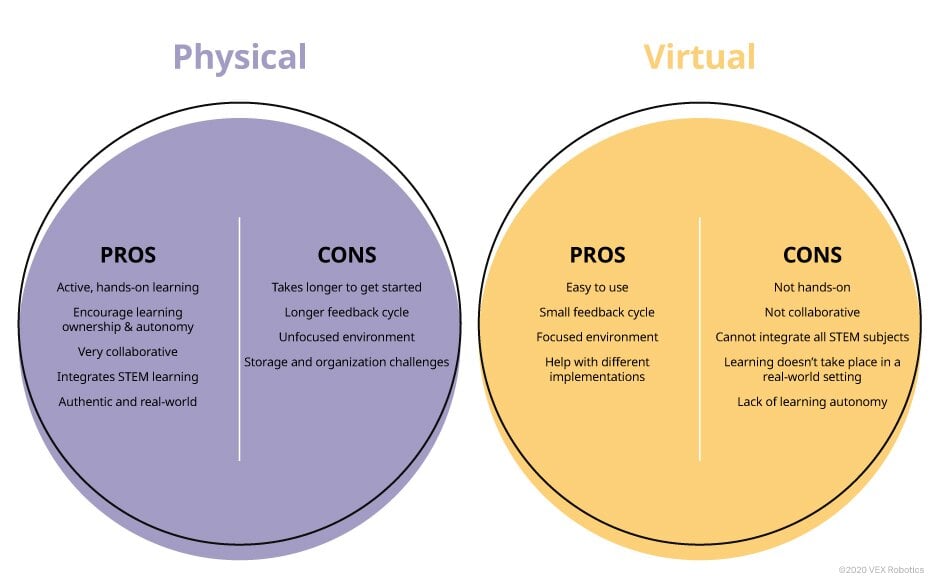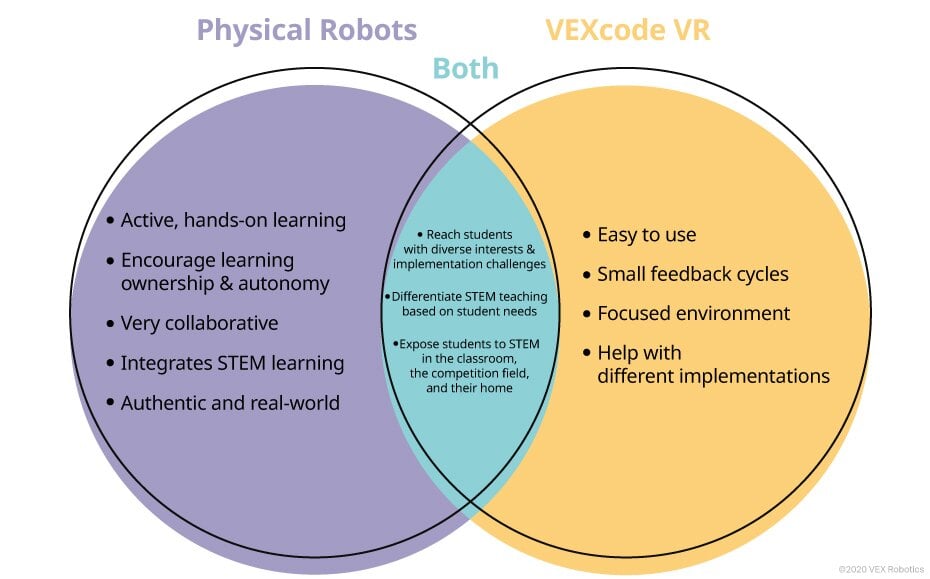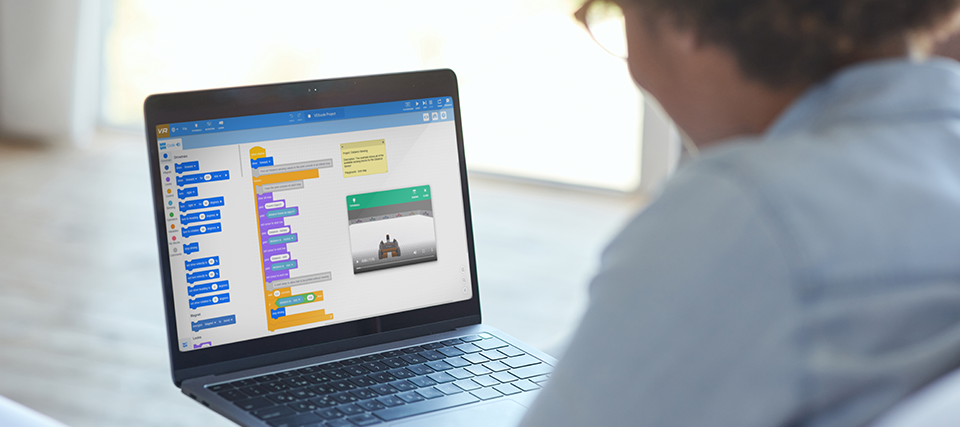VEXcode VR, Remote Learning About VEX Robots
VEXcode VR is for experimenting with different ways to program a robot. To encourage self-directed learning, new projects can be created and played in seconds, immediate feedback is provided, and both sensor data and the program execution is made visible for the learner. VEXcode VR is a way to enrich the CS experience for students after they have discovered the excitement of educational robotics with other VEX platforms.
Easy to use
VEXcode VR is web-based, so launching VEXcode VR is easy. The user interface makes navigation simple. Commands are divided into categories avoiding a potentially overwhelming list of commands. Commands are also color-coded so users can easily find related blocks. The programming area is always visible; inviting learners to begin coding. VEXcode VR utilizes prebuilt robots and drivetrain commands. This allows users to code a robot to move within moments.
Immediate Feedback
VEXcode VR encourages experimentation and play. When students run a project, they can immediately see if their robot produced the intended result. It is easy for teachers to provide feedback. A project in VEXcode VR will always run the same way–this doesn’t always occur with a physical robot. This allows teachers and students to focus on the logic of the programming, not the physics of the robot or the field where the robot is being run. The VR Robot always begins in the same location and isn’t impacted by friction. Learners can add blocks while their project is running, stop the project at any point, and reset their virtual playground with one click. Blocks that are not connected to the main stack are just ignored when the project is run. There are no errors in VEXcode VR. Students may make logic mistakes when coding, but they will not become frustrated that their projects will not compile and run. VEXcode VR’s ability to provide immediate feedback and its ease of use encourage students to learn while they code and supports a bottom-up approach to writing projects where small snippets of code are created, tested and then combined into larger behaviors.
Learning Made Visible
The Playground window in VEXcode VR contains a dashboard that displays all of the sensor data from the VR Robot. Anytime the VR Robot runs, learners can see the sensor data update in real-time, providing them with information on how the data can be used.
This real-time data can help learners make abstract concepts (e.g. How does my robot make a decision?) more visible and concrete.
VEXcode VR also highlights the blocks within a project when those blocks are being executed. This feature allows learners to observe the program flow of their projects. When a VEXcode VR project is running, the block that is being executed is surrounded by a glowing green border. This feedback helps learners to understand why the VR Robot is performing a particular behavior.
Students can also Step through their projects by using the step button in the toolbar.
When a user steps through a project, the block is first highlighted in green to show that it is the next command to be run. When the user selects Step again, the action of the block gets executed and the green border blinks.
The step feature provides students with a visual representation of the flow of the commands as they are being executed within a project. This provides students with important visual cues when they are trying to troubleshoot or design a program
Learning with VEXcode VR
Often when we learn a new skill, we use different supports. VEXcode VR is a great platform to learn specific Computer Science (CS) concepts because it can sometimes be easier for students to learn those concepts with the supports (easy to use, immediate feedback, learning made visible) provided by VEXcode VR.
When working to learn or strengthen a new skill, it is useful to focus directly on that skill. This is why people often like to study at a library or a quiet Starbucks–the environment helps them to focus. VEXcode VR provides a focused learning environment. Learners don’t have to worry that their motor is plugged into the wrong port or that their robot started the challenge in the incorrect position.
VEXcode VR also helps with classroom implementations. Students miss school due to illness and vacations. Students do not learn at the same pace. Teachers have to plan for and accommodate students who move into their district during the school year. In all of these situations (and more) VEXcode VR can be a great supplement for physical robots.
Using Real Robots
The National Science Teaching Association (NSTA) recently published its STEM education teaching and learning position statement. This statement identified that STEM education occurs when:
- Learning is viewed as an active, constructive process, and not a receptive one
- Student motivation and beliefs are integral to cognition
- Social interaction is fundamental to cognitive development
- Knowledge, strategies, and expertise are contextualized in the learning experience
As I have argued elsewhere, the use of physical robots is a tremendous way to organize a learning environment to meet the above-mentioned needs of STEM education. This occurs frequently in both classrooms and competition fields. This cannot occur in VEXcode VR.
Moreover, the goal of all education is application. We want students to apply what they learn to a real world problem or scenario. We don’t want students to become great writers on just one prompt, we want them to be able to apply those writing skills to many different contexts. Robotics is a great way for students to apply and contextualize their CS skills in a real-world context.
Using VEXcode VR and Physical Robots together
The virtual robots and playgrounds of VEXcode VR are designed to supplement STEM learning, not to supplant the application of knowledge and skills, integrated through real-world experiences, while students collaborate with their peers — the essence of STEM education.
As the figure below shows, using VEXcode VR and physical robots together provides you with the advantages of each, but there are also unique benefits of using them together.


